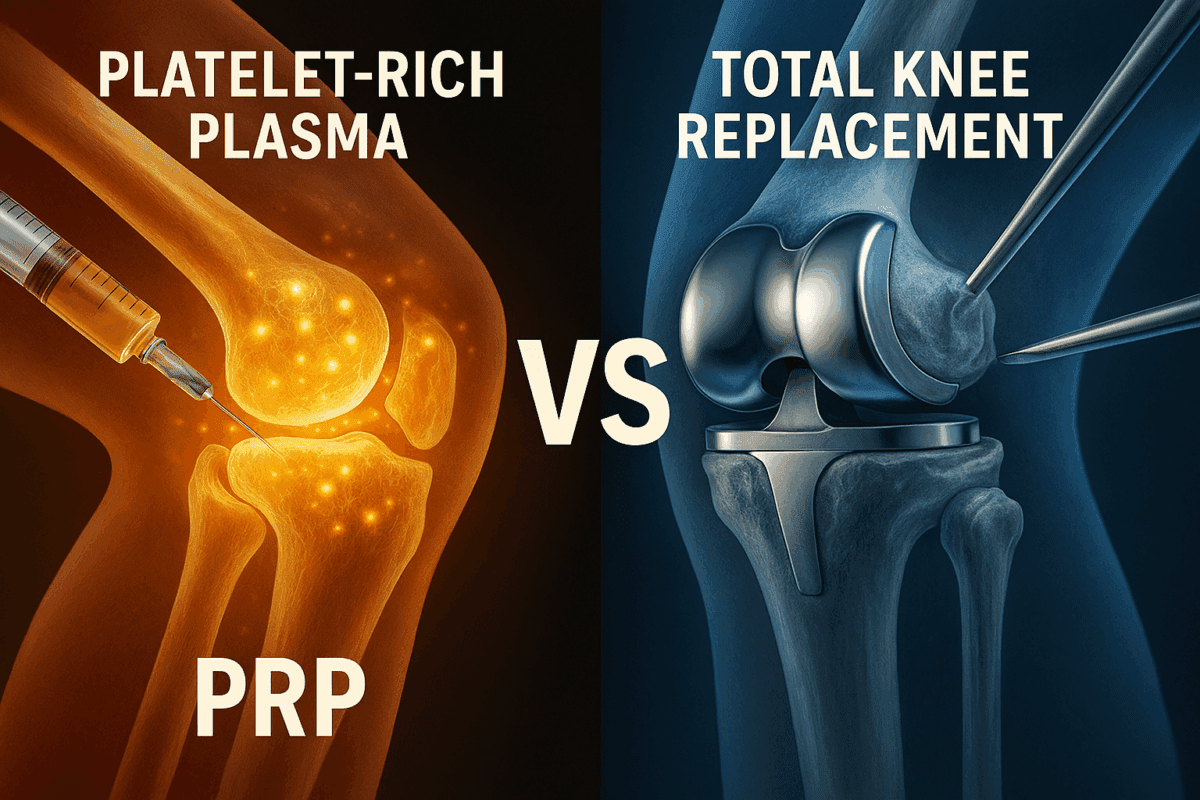PRP vs. Total Knee Replacement: The Definitive Choice Between Repair and Relinquishment

PRP vs. Total Knee Replacement: The Definitive Choice Between Repair and Relinquishment
For those suffering from the relentless agony of knee osteoarthritis (OA), the medical path often presents a dramatic fork: the definitive, irreversible act of Total Knee Replacement (TKR), or the intelligent, biological leap toward Platelet-Rich Plasma (PRP) therapy. This is not a choice between two equals; it’s a profound decision between surgical forfeiture and sophisticated self-repair, and a deeper look at the data particularly the hidden surgical risks compels a re-evaluation of the standard treatment hierarchy.
1. The Heavy Truth About Total Knee Replacement
TKR, at its core, is a major, life-altering surgery – a dramatic reconstruction where the damaged joint is literally amputated and substituted with artificial components of metal and plastic. This is an option one can never undo.
| Patient Dissatisfaction | Despite technical success, the ultimate metric fails: Apart from about a 5% failure rate, a staggering 20-25% of patients report being unhappy post-TKR. This profound dissatisfaction often stems from persistent stiffness, residual pain, and the chronic, unnerving sensation of an “insensate” or foreign joint—a permanent disconnect between mind and limb. |
| Drawback of Replacement | Drawback of Replacement The Alarming Statistics & Implications |
The Fracture Risk | Even primary surgery holds inherent risks, including the rising incidence of Peri-prosthetic Fractures around the implant, an event that can complicate recovery significantly and occur in up to 5 – 25% of cases (Pellegrino et al 2022, Canton et al 2017). |
| The Burden of Revision Surgery | While the primary implant may last a decade or more, the chance of needing a Revision TKR is astonishingly high, cited up to 38% in published literature (Benkovich et al 2020). Crucially, these subsequent surgeries are technically grueling, characterized by notably decreased success rates and substantially higher rates of complications. |
| The Mortality Factor | Perhaps the most chilling statistic is the documented one-year mortality rate following a revision TKR, which ranges alarmingly between 11% and 44.8% (Pezzella et al 2020). This alone should elevate TKR from a simple medical procedure to a last-resort measure carrying non-trivial life risks. |
2. PRP: Embracing the Body’s Intelligent Solution
In sharp contrast, Platelet-Rich Plasma (PRP) therapy introduces a powerful, minimally invasive strategy rooted in regeneration. Though it can not correct severe deformities which can sometimes develop in advanced osteoarthritis of the knee, it is a highly effective biological intervention that respects and utilizes your body’s inherent capacity for healing.
How is this achieved? A small quantity of the patient’s own blood is drawn and spun rapidly to isolate a potent concentration of platelets—tiny powerhouses loaded with hundreds of growth factors and specialized signaling proteins. This concentrated solution is then precisely injected into the damaged area of the knee.
- Minimally Invasive: PRP is an office-based injection; it demands no general anesthesia, no hospital stay, and zero large incisions. Consequently, the patient is back on their feet and resuming normal life activities within a day or two, not months.
- The Healing Mechanism: Unlike a replacement, PRP actively works to reduce the destructive inflammation that fuels OA progression while simultaneously encouraging chondrocytes (cartilage cells) to repair and produce new, native cartilage matrix. The goal is simple: restore, not replace!
- Preserving the Natural Joint: The profound advantage of PRP is the preservation of the patient’s original, biomechanically perfect knee. By retaining natural anatomy and function, PRP completely bypasses the risk of the “insensate” knee and the long-term, devastating surgical complications detailed above.
- A Strategy for Time: For the majority of patients, especially those in their 40s or 50s who stand a very real chance of outliving a typical TKR implant and thus facing a highly dangerous revision surgery, PRP is the essential delaying maneuver. It provides crucial years of pain relief and function without crossing the surgical Rubicon. It can often help avoid TKR, if treatment is started early and combined with other supplementary treatments and lifestyle modifications.
The Definitive Verdict: When Is Which Appropriate?
The era of simply recommending TKR as a default option must end. The data on patient dissatisfaction and surgical risk demands a more conservative approach.
TKR is an option for the unsalvageable: It should be strictly reserved for patients suffering from absolute, end-stage, “bone-on-bone” arthritis where the joint structure is completely compromised, joint deformed and every other non-surgical avenue has failed. It is the final answer, not the first.PRP is the intelligent, first-line answer: For the vast majority of patients struggling with mild to moderate OA, and also for patients who do not want to go through the risks of surgery, the path forward should unequivocally involve PRP. It offers a powerful, low-risk, biological intervention that harnesses the body’s own power to heal, offering profound pain relief and mobility without incurring the severe risks, guaranteed downtime, and high potential for dissatisfaction associated with total joint replacement.
Sources used for statistics:
| Statistic Referenced | Source Link (Journal Article/Review) |
| Revision Surgery Rate (up to 38%) and Mortality Risk | Periprosthetic fractures of the knee: a comprehensive review. Benkovich V, et al. PMC – NIH. 2020. https://pmc.ncbi.nlm.nih.gov/articles/PMC7138771/ |
| High Mortality Following Revision Surgery (11-44% range) | Differences in mortality and complication rates following revision knee arthroplasty performed for urgent versus elective indications. Kazi et et al. PubMed. 2021. https://pubmed.ncbi.nlm.nih.gov/34587801/ |
| Patient Dissatisfaction Rate (20-25%) | Patient Satisfaction after Total Knee Arthroplasty: Who is Satisfied and Who is Not? Parvizi J, et al. NIH – PMC. 2009. https://pmc.ncbi.nlm.nih.gov/articles/PMC2795819/ |
| Primary TKR Fracture Risk (General Range) | Risk and Epidemiology of Periprosthetic Knee Fractures After Primary Total Knee Arthroplasty: A Nationwide Cohort Study. PubMed. 2024. https://pubmed.ncbi.nlm.nih.gov/38759816/ |
